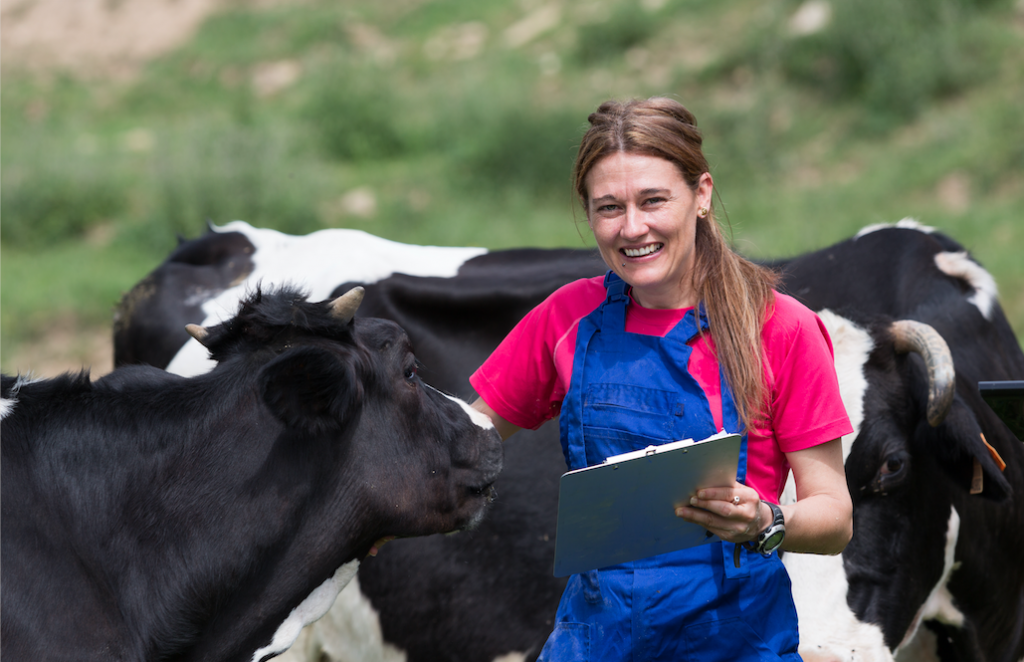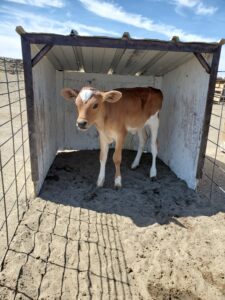As Nevada Dairy Farmers, We Treat Our Cows with Respect and Compassion
We do this to maintain a healthy and comfortable herd of cows, it is a top priority for us and all dairy farmers. It’s incredibly important that the herd is compassionately and correctly cared for from day one, which is why when a cow is getting close to having a calf, she is monitored very closely and put in an area designed for calving. This area is clean, comfortable and secluded from the rest of the herd. Our farmers watch the cow from nearby in order to be able to step in to help during labor, if needed, but usually cows do just fine on their own.
Calves Live in a Comfortable, Caring Setting
Once the baby calf is born, the mother needs to get up to clean the calf. Sometimes she does this on her own and sometimes she is too tired from giving birth, so we give her a hand. Calves become mobile quickly, in fact, within the first few hours they’re already walking. Once this has happened, the calf gets its very own cozy hut and is bottle fed the mother’s first milk after birth, called colostrum. It is a thicker immune-boosting milk and goes straight to the calf for their first meal.
In the first few weeks of a calf’s life they are monitored very closely. They are bottle-fed milk twice (sometimes three times) each day and have their own hutch with a small yard so they can move in and out as they please. Individual housing for each calf allows farmers to closely monitor their development and assure they receive the best nutrition. During this first month they will be evaluated by the vet to ensure they are developing as expected and receiving a healthy, balanced diet.
Soon Calves Mature into the Happy Cows that Provide us with Nutritious (and Delicious!) Milk
Around the 40 day mark, calves are moved into large community pens along with other heifers. Dairy cows are called heifers prior to birthing a calf — afterward, they are cows. When heifers mature to this point, they are no longer bottle fed and transition to a hay and grain diet. The pens are large with plenty of space to roam and offer areas with sun or shade. If they prefer to rest or take a nap, there are comfortable areas with beds of soft sand. At roughly two years of age, heifers have reached full maturity. At this time they are inseminated and are soon to begin the next step in their lives — motherhood! Between 9-10 months later, they will have their first calf and the process begins again for the calf.
After a heifer has borne a calf, she will join the milking herd and be moved to another large pen with other cows. The pens are large open spaces with sun, shade, and sand for bedding. In the warmer months the cows are kept cool and comfortable with shade and in some cases fans and misters. Corrals are groomed 2-3 times a day to remove any existing bedding and pull in soft, dry bedding. Farmers go to great lengths to make sure their cows are clean and comfortable.
The Happier the Heard, the Better they Produce!
To ensure optimal milk quality and a healthy herd, farmers work with specialized nutritionists and veterinarians. Nutritionists help develop balanced diets that contain good sources of protein, fat, fiber, vitamins and minerals from feed mixtures that include grasses, alfalfa, cottonseed, corn and almond hulls. Often the cows are consuming things that humans cannot utilize. They are great recyclers! The ratios and amounts of the various feeds are formulated for cows based on where they are in their lifecycle. They also have clean, fresh water available 24 hours a day to maintain hydration. Cows receive regular veterinary check-ups as well. Occasionally, just like us, cows get sick and when this happens the cow is isolated from the rest of the herd until she has been cleared by the vet to return. Strict systems are in place, including rigorous testing both on the farm and at the processing plant, to ensure that milk is of the highest possible quality. Because we know better than anyone, the best milk comes from the healthiest and happiest herd.
Want to Get More Diggs on your Local Dairies and How they Care for Their Herd?
Nevada dairy farmers actively participate in the National Dairy FARM® program, a nationwide, verifiable animal well-being program. Have more questions about our dairy farms? Ask an expert or engage with us on Facebook.



